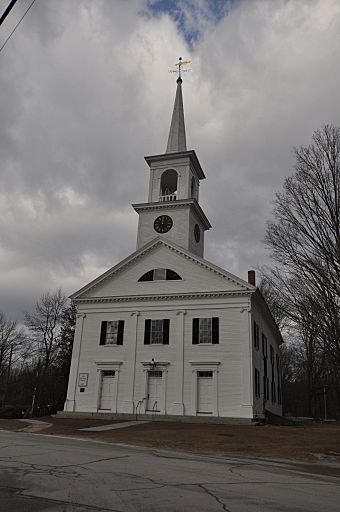Francestown Meetinghouse facts for kids
Quick facts for kids |
|
|
Francestown Meetinghouse
|
|
 |
|
| Location | NH 136, Francestown, New Hampshire |
|---|---|
| Area | 0.5 acres (0.20 ha) |
| Built | 1803; 1837 |
| Architect | Patch, Isaac; Patch, William |
| Architectural style | Greek Revival |
| NRHP reference No. | 99000667 |
| Added to NRHP | June 14, 1999 |
The Francestown Meetinghouse is a very old and important building located on Route 136 in the center of Francestown, New Hampshire. It's a white building with wooden siding, and it was first built around 1801 to 1803. It was updated in 1837 with a special style called Greek Revival. For many years, it was used as a church until 1987. It also served as a place for town meetings until 1833. This historic building was added to the National Register of Historic Places in 1999, which means it's recognized as a special place in history. Today, a group that doesn't make a profit takes care of it, using it as a helpful place for the community.
About the Meetinghouse
The Francestown Meetinghouse stands out in the middle of Francestown village. It's on the east side of where Main Street meets New Boston and Greenfield roads. This building has two stories and is made of wood, covered with white clapboards. It has a pointed roof.
What Does It Look Like?
The front of the building looks a bit like an ancient Greek temple. It has four tall, flat columns called Doric pilasters that go up two stories. These support a decorative band and a triangular top part called a pediment. Inside the pediment, there's a half-circle design.
The building also has a tall tower with two square sections. On top of these is a steeple. The first section of the tower holds a clock that belongs to the town. The second section has an open area with rounded arch openings, which is where the church bell would have been.
A Look Back in Time
Francestown's first meetinghouse was built close to this spot between 1801 and 1803. It took a while to build because the community wasn't very wealthy. A meetinghouse was a special kind of building used for both religious services and town meetings.
For many years, this meetinghouse was shared by two different church groups: the Congregationalists and the Presbyterians. They even shared a minister whose pay came from public money. But in 1825, a new church group, the Calvinists, didn't agree with having a minister paid by taxes.
In 1833, the town decided to sell its part of the building. The Congregationalist church group then became the full owners. Later, in 1877, there was a disagreement within the Congregationalist group that led to a court case. The court decided that a different society (a group that managed the building) owned it, and the church group had to leave.
Even after this, the building was mostly used for church services until 1987. That year, it was sold to a local non-profit organization. This group now uses it as a community center, a place for everyone in Francestown to gather and use.
See also



